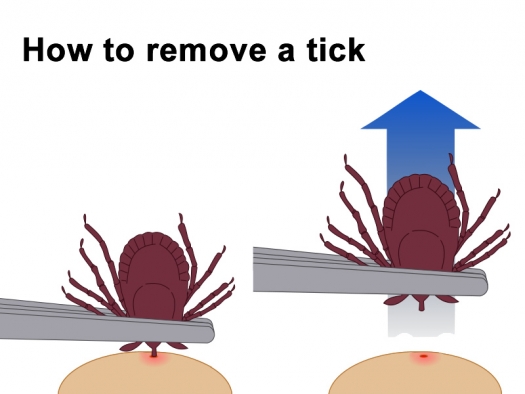TickRemovalIllustration.jpg

Illustration is a derivative work by FAIM of an image by Doc James, which is a derivative work of an image from the Centers for Disease Control and Prevention / Wikimedia Commons, public domain
How to remove a tick
- Grab a set of fine tweezers and use them to grasp the tick. Try to grab it as close to the surface of your skin as you can.
- Using gentle but firm and steady pressure, slowly pull upward – avoiding any jerking or twisting.
“I’d rather treat cancer than chronic Lyme disease.” This was the phrase uttered by another physician to one of my patients who had just acquired a tick bite.
This may sound extreme, but Lyme disease can be a devastating and daunting condition. Every month in my practice I see patients who had a tick bite years ago and continue to suffer from inflammatory reactions, immune dysfunction, and even neurologic symptoms. And to think, all that trouble was from a tiny, long-ago tick that happened to carry the bacteria that causes Lyme disease.
And while we’ve come a long way in understanding and treating Lyme disease, as the saying goes – an ounce of prevention is worth a pound of cure. So today we’re going to dive into some simple yet powerfully effective steps to prevent Lyme disease.
Lyme disease symptoms
Lyme disease is an infection caused by a bacterial species named Borrelia burgdorferi. This bacteria is known for being particularly tricky and has even been nicknamed “The Great Imitator” because of its ability to imitate other conditions.
A Borrelia burgdorferi infection can trigger a systemic infection that can cause a wide array of symptoms that can mimic other conditions such as:1
- Alzheimer’s disease
- Multiple sclerosis
- Fibromyalgia
- Rheumatoid arthritis
- Chronic fatigue syndrome
- Schizophrenia
While Lyme disease can sometimes be tricky to pinpoint, there are a few specific acute signs of Lyme disease to watch for. If you notice that you’re feeling fatigued, fever, flu-like symptoms, and/or have a bullseye-shaped rash, you may have contracted this stealthy intruder.
So, how do you get Lyme disease?
Lyme disease is transmitted to humans almost exclusively through the bite of black-legged deer ticks that carry the Borrelia burgdorferi bacteria. You see, when a tick bites you, it can directly inject Borrelia burgdorferi (and any other infectious microorganisms it may be harboring) directly into your bloodstream.
And what’s worse, the geographical areas where Lyme disease is a significant risk are expanding in all directions. Areas that are known to be hot spots for ticks are of the most concern – the Northwest, [the Northeast], Minnesota, Iowa, Michigan, Wisconsin, Florida, and parts of California.
Due to urban expansion into previously undisturbed habitats for deer and mice, Lyme disease is spreading to new locations nearby and becoming an epidemic in certain counties in the United States. In fact, about 20,000 to 30,000 cases are reported in the US every year, but experts say that the actual number could be 10 times greater.2
So it’s more important than ever to understand how you can take steps to protect yourself and your loved ones from contracting this daunting disorder.
How to prevent Lyme disease?
Fortunately, there are some simple and effective ways you can protect yourself and prevent Lyme disease. Here are my best Lyme disease prevention tips:
- Wear protective clothing: When outside, wear pants and long sleeves to keep your skin from being exposed. Light-colored clothing is preferred, so you can easily see if a tick has made their way onto you. I also recommend pretreating your clothing, boots, socks, and camping equipment with bug repellant, such as 20-30% DEET or the preferred less toxic 20% picaridin or 30% oil of lemon eucalyptus. Studies have found that these natural repellents worked better than DEET, which is neurotoxic.3
- Walk in the center of trails and avoid heavily wooded areas: Ticks hide out in the grass, brush, leaves, and trees where they wait for their next meal to walk by. When you walk past, they leap from their hideout and onto you. So walking in the center of trails and avoiding brushing up against grass, branches, or leaf litter can keep them at bay.
- Bathe or shower within a few hours of camping or hiking: Have a friend or family member do a “tick check” before you hop in the shower. Ask them to examine your back and scalp and other areas that you might not be able to see well. Washing and drying clothes on high for 30 minutes should kill any ticks that are attached to your clothing.
- Check your dogs: Many people don’t realize that their beloved dogs (and horses, too) can carry ticks that transmit Lyme disease. Be sure to check your pets after hiking or camping in wooded areas and remove any ticks that you see right away.
The biggest key to Lyme disease prevention is avoiding ticks. But even if you follow all steps to avoid these creepy crawlers, you still might have a run-in. So it’s important to know exactly how to remove a tick if one of these sneaky bugs do make their way onto you or your pets.
How to remove a tick
It can be unsettling to think of one of these little buggers sinking their teeth into you. But if you do notice a tick, it’s crucial to remove it promptly and properly. The proper way to remove a tick is to follow these steps:
- Grab a set of fine tweezers and use them to grasp the tick. Try to grab it as close to the surface of your skin as you can.
- Using gentle but firm and steady pressure, slowly pull backward – avoiding any jerking or twisting.
- Continue pulling with gentle pressure. You want to avoid squeezing, crushing, or puncturing the tick as its bodily fluids can contain a number of infection-causing organisms.
- Once you’re able to pull the tick out, be sure to thoroughly wash the bite area and your hands with soap and water.
- If the tick’s mouthparts are stuck in the skin, they should be left alone as attempting to remove them can cause significant trauma to your skin. As the bite heals, these parts will be naturally expelled on their own.
- Once removed, submerge the tick in rubbing alcohol in a sealed bag or container. Placing the tick in alcohol not only kills the tick, but also allows you to preserve it to be used for identification and testing if you begin experiencing any symptoms after the bite.
If you do acquire and properly remove a tick and begin experiencing symptoms, I cannot overemphasize the importance of seeking out the guidance of an experienced Integrative and Functional Medicine Practitioner. They can help you accurately identify the presence of Lyme disease and any other infectious organisms that may have made their way into your body. Then they’ll come up with a comprehensive plan to get you on the path to healing.
So, how worried should I be when it comes to Lyme disease?
Lyme disease is a very real concern. This tricky bacteria can cause devastating symptoms that can be difficult to pinpoint and treat. While Lyme disease is certainly not a condition to be taken lightly, the good news is, there’s no need to give up your outdoor adventures from fear of contracting this nasty bug.
When it comes to protecting yourself and your loved ones from Lyme disease and other tick-borne diseases, a little preparation can go a long way. Follow the steps outlined in this article to ensure your summer adventures are fun and safe at the same time.
References
- Lyme disease: the latest great imitator – PubMed (nih.gov)
- Lyme and Other Tickborne Diseases Increasing | CDC Online Newsroom | CDC
- Mosquito Repellent and Bug Spray: Picaridin and Lemon Eucalyptus Win | Time
Preventing Lyme Disease: Simple Steps to Keep You Safe was originally published on Dr. Jill's website, July 19, 2015. Used with permission.


